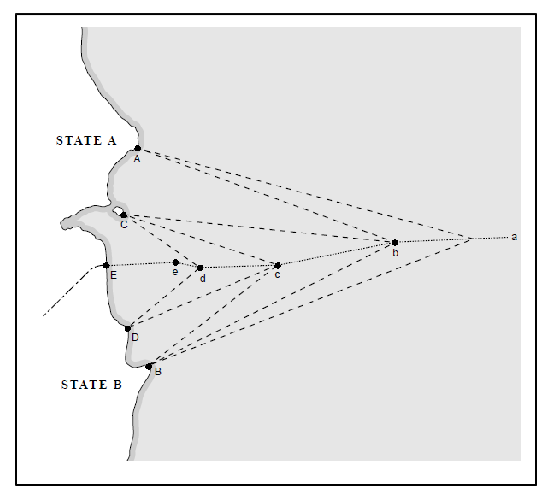As used in UNCLOS Articles 15, 74(1) and 83, “adjacent coasts” means coasts lying on either side of the land boundary between two adjoining States. States may have adjacent coasts under UNCLOS even if they do not share a common land boundary.
Comment
In LOAC-governed situations under the “other rules of international law” clauses in UNCLOS, a different definition may apply. The same may be the situation if the UN Charter supersedes UNCLOS or if jus cogens norms apply.
Consolidated Glossary ¶ 1 defines “adjacent coasts” as “the coasts lying either side of the land boundary between two adjoining States.”
UNCLOS Article 15, echoing Territorial Sea Convention Article 12(1), provides that Where the coasts of two States are opposite or adjacent to each other, neither of the two States is entitled, failing agreement between them to the contrary, to extend its territorial sea beyond the median line every point of which is equidistant from the nearest points on the baselines from which the breadth of the territorial seas of each of the two States is measured. The above provision does not apply, however, where it is necessary by reason of historic title or other special circumstances to delimit the territorial seas of the two States in a way which is at variance therewith.
Territorial Sea Convention Article 14(1) also provides that The boundary of the territorial sea between two adjacent States shall be determined by agreement between them. In the absence of such agreement, and unless another boundary line is justified by special circumstances, the boundary is drawn by application of the principle of equidistance from the nearest points on the baseline from which the breadth of the territorial sea of each country is measured.
With respect to the continental shelf, UNCLOS Article 76(10) provides that Article 76’s other terms “are without prejudice to the question of delimitation of the continental Shelf between States with opposite or adjacent coasts.” The Shelf Convention does not have an equivalent provision, but its Article 6 provides:
1.Where the same continental shelf is adjacent to the territories of two or more States whose coasts are opposite each other, the boundary of the … shelf appertaining to such States shall be determined by agreement between them. In the absence of agreement, and unless another boundary line is justified by special circumstances, the boundary is the median line, every point of which is equidistant from the nearest points of the baselines from which the breadth of the territorial sea of each State is measured.
2.Where the same continental shelf is adjacent to the territories of two adjacent States, the boundary of the … shelf shall be determined by agreement between them. In the absence of agreement, and unless another boundary line is justified by special circumstances, the boundary shall be determined by application of the principle of equidistance from the nearest points of the baselines from which the breadth of the territorial sea of each State is measured.
3.In delimiting the boundaries of the continental shelf, any lines which are drawn in accordance with the principles set out in paragraphs 1 and 2 … should be defined with reference to charts and geographical features as they exist at a particular date, and reference should be made to fixed permanent identifiable points on the land.
UNCLOS Article 83 is different:
1.The delimitation of the continental shelf between States with opposite or adjacent coasts shall be effected by agreement on the basis of international law, as referred to in Art[.] 38 of the Statute of the International Court of Justice, … to achieve an equitable solution.
2.If no agreement can be reached within a reasonable period of time, the States concerned shall resort to the procedures provided for in Part XV[, UNCLOS dispute resolution procedures, Articles 279–99].
3.Pending agreement as provided for in paragraph 1, the States concerned, in a spirit of understanding and cooperation, shall make every effort to enter into provisional arrangements of a practical nature and, during this transitional period, not to jeopardize or hamper the reaching of the final agreement. Such arrangements shall be without prejudice to the final delimitation.
4.Where there is an agreement in force between the States concerned, questions relating to the delimitation of the … shelf shall be determined in accordance with the provisions of that agreement.
UNCLOS Article 74(1) recites principles for the EEZ between States with opposite or adjacent coasts analogous to those for the continental shelf in Article 83.
Under UNCLOS Article 47(6), if part of an archipelagic State’s archipelagic waters lies between two parts of “an immediately adjacent neighboring State,” existing rights and all other legitimate interests the latter State has traditionally exercised in such waters and all rights in agreements between those States must continue and be respected.
Although “adjacent States” usually is thought of where States have a common land boundary, it is possible that two States may have adjacent coasts even though they do not share a common land boundary.

